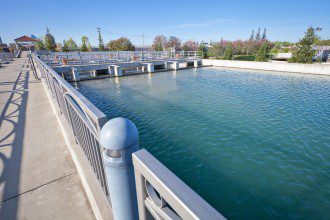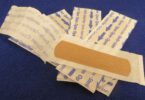16th November 2015
Contributing Writer for Wake Up World
As if California doesn’t have enough worries with its current record-breaking drought, a city in the northern part of the state has created further problems by adding a chemical to their water supply that encourages carcinogen formation. Astoundingly, the City of Sacramento continued testing the chemical in the municipal water supply for an entire year — even after it was discovered the compound creates harmful disinfection byproducts, or DBPs.
The chemical in question? Aluminum chlorohydrate (ACH), a coagulant that bonds with silt and other impurities found in river water. Once bonded, sediment falls to the bottom of treatment plant pools, where it’s then removed. The trouble is, the chemical was a complete failure. According to city officials, DBP numbers rose to “historically high levels when using (ACH) aluminum chlorohydrate.” These disinfection byproducts are associated with cancer, low birth weight and miscarriages. In spite of this, city officials soldiered on with the chemical because they were focused on saving the city “quite a bit of money” and not much else.
[pro_ad_display_adzone id=”110028″]
Flawed Safety Protocol
Once the testing began with ACH, worrying data rapidly presented itself. A city chemist picked up on the problem by the third day. “I’m nervous about the distribution samples,” she wrote in an email to managers. A chart included with the message clearly showed DBPs were well above Environmental Protection Agency (EPA) limits.
Instead of stopping the test immediately, officials expanded their efforts with ACH, informing the city council they needed enough funding to purchase a truckload of the chemical each week for a full year. The price tag of this request: $850,000.
When officials realized the chemical was ineffective, the city added more chlorine into the water supply. But the increased chlorine bound with organic compounds, creating harmful DBPs.
In the meantime, residents of the district were not warned about the contaminated water, which is particularly dangerous when inhaled as a mist while showering or washing dishes.
Reports ABC10 news:
“A man who grew up working in the water treatment industry, Bob Bowcock, said what the city did endangered the health of citizens. “This community was basically looked at as a laboratory guinea pig, in that they were exposed to violation level trihalomethanes for up to one year without any proper notification whatsoever,” Bowcock said. Trihalomathane is one type of DBP. They’re often referred to THMs.”
When asked by the news agency why his department didn’t share the alarming data with the public and with regulators, utilities director Bill Busath replied, “As long as we were in compliance, we don’t need to contact them.”
Busath is correct. According to the law, unusually high levels of DBP don’t need to be reported unless the annual average of quarterly samples exceeds the safe drinking water standards established by the EPA. But here’s the rub… ABC news discovered one quarterly sample was taken from a plant on the American River, not the Sacramento River Plant — which is where the chemical trials were being performed. And emails show that the city deliberately “switched water sources from the city to the county, days before and EPA test.”
Evidently, if the city hadn’t used water from another source, it would have surpassed yearly limits for disinfection byproducts.
The investigation by ABC news found “data showing dozens of readings in excess of the EPA standard of 80 parts-per-billion during the year-long trial. In the Westlake neighborhood, near Sleep Train Arena, during a two-month period between August and October 2013, 11 of 13 readings were above EPA limits. Then in March of 2014, readings were way up across the city. Some people were drinking water with DBP levels above 130 parts-per-billion.”
Busath claims everything the city did was completely legal — including changing water sources.
The case has caught the eye of Erin Brockovich, who is known for her role in uncovering chemically-tainted water in Hinkley, California.
“I would light up the city council, make sure that there are repercussions, and every assurance it doesn’t happen again and that you are delivering safe drinking water to every person in your district,” she advised.
In a sad twist of irony, journalists Thom Jensen and Joe Rubin of ABC10 note:
“In the end, the alleged money savings Utilities Director Busath was talking about appears to have been overstated or completely wrong. The staff members said in a report to council that they expected to save up to a million dollars using ACH. But, ABC10 found the department used bad data. The actual numbers show that not only was the original chemical safer, it appears it was also cheaper.”
Article sources:
- www.water-research.net/index.php/trihalomethanes-disinfection
- www.abc10.com/story/news/investigations/2015/11/04/75112994
- www.theantimedia.org/officials-secretly-added-cancer-causing-chemicals-to-citys-water-supply
Previous articles by Carolanne Wright:
- Considering the Flu Shot? Here are Five Reasons to Think Twice
- Dr Sebi: The Man Who Cures Aids, Cancer, Diabetes and More
- Plastic-Eating Mushroom Discovered in the Amazon Rainforest — A Solution for Our Trash Saturated World?
- Chronic Lyme Disease: A Modern Plague the Government Chooses to Ignore
- Big Pharma and Organized Crime — They are More Similar Than You May Think
- Over 100 Scientific Studies Agree: Cannabis Annihilates Cancer
- Emotional Energetic Healing: The Future of Medicine is Here
- Why Every Parent Should Consider Unschooling
- The Greenhouse of the Future: Grow Your Own Food Year-Round With This Revolutionary System
- First U.S. City Produces More Electricity Than It Uses — With 100% Renewable Technology
- Autistic Boy with Higher IQ Than Einstein Discovers Gift After Removal from State-Run Therapy
[pro_ad_display_adzone id=”110025″]
[pro_ad_display_adzone id=”110027″]







